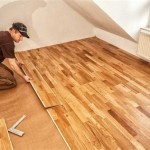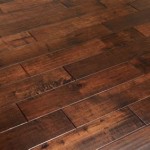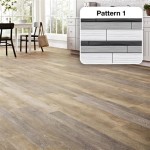How to Repair Vinyl Flooring Seams
Vinyl flooring, known for its durability, affordability, and ease of installation, is a popular choice for various residential and commercial applications. However, even with proper installation and maintenance, seams in vinyl flooring can sometimes separate, creating unsightly gaps and potential hazards. Addressing these issues promptly is crucial to prevent further damage and maintain the integrity of the flooring surface. This article provides a comprehensive guide on how to effectively repair separated seams in vinyl flooring.
Several factors can contribute to the separation of vinyl flooring seams. Improper installation is a primary cause, often stemming from inadequate preparation of the subfloor, insufficient adhesive application, or incorrect seam alignment during the initial installation process. Fluctuations in temperature and humidity can also play a significant role, causing the vinyl material to expand and contract, which can stress the seams over time. Additionally, heavy foot traffic, furniture movement, and exposure to excessive moisture can weaken the adhesive bond and lead to seam separation.
Before commencing any repair work, it is essential to accurately assess the extent of the damage and determine the underlying cause of the seam separation. This assessment will help in selecting the appropriate repair techniques and materials. A thorough inspection should identify the length and width of the separated seam, any signs of subfloor damage, and the type of adhesive originally used. Understanding these details will ensure a more effective and lasting repair.
Identifying the Necessary Tools and Materials
Successful vinyl flooring seam repair requires a specific set of tools and materials. Gathering these items beforehand will streamline the repair process and minimize potential delays. The essential tools include a utility knife with sharp blades, a seam roller, a heat gun or hairdryer, a vacuum cleaner, and a clean, damp cloth. In addition to these tools, specific materials are needed, such as seam sealant or vinyl seam adhesive, double-sided flooring tape, and potentially a matching vinyl flooring scrap piece if the gap is excessively wide or damaged. The selection of the appropriate seam sealant or adhesive is crucial for achieving a durable and aesthetically pleasing repair. Carefully review the product specifications and ensure compatibility with the existing vinyl flooring material.
A utility knife is indispensable for trimming excess material and precisely aligning the edges of the separated seam. The seam roller is used to apply pressure and ensure proper adhesion between the vinyl flooring and the seam sealant or adhesive. A heat gun or hairdryer can soften the vinyl material, making it more pliable and easier to work with, particularly when dealing with stubborn or tightly closed seams. A vacuum cleaner is essential for removing any debris or dirt from the seam area, ensuring a clean bonding surface. Finally, a clean, damp cloth is used to wipe away excess sealant or adhesive and clean the repaired area.
The choice of seam sealant or adhesive depends on the type of vinyl flooring and the severity of the seam separation. For minor gaps, a vinyl seam sealant specifically designed for flooring applications is often sufficient. These sealants are typically available in a variety of colors to match the existing flooring and provide a flexible, water-resistant bond. For larger gaps or areas subject to heavy traffic, a stronger vinyl seam adhesive may be necessary. These adhesives provide a more permanent bond and are often recommended for commercial applications or areas prone to moisture exposure. Double-sided flooring tape can be a helpful addition for temporarily holding the edges of the seam together while the sealant or adhesive cures. This tape provides added stability and helps ensure proper alignment during the drying process.
Step-by-Step Repair Process
The actual repair process involves several key steps to ensure a successful outcome. Preparation is paramount; the first step involves thoroughly cleaning the separated seam area. Use a vacuum cleaner to remove any dirt, dust, or debris that may have accumulated within the gap. Following vacuuming, use a damp cloth to wipe the area clean, removing any remaining residue. Ensure the area is completely dry before proceeding to the next step. This cleaning process ensures optimal adhesion of the sealant or adhesive to the vinyl flooring.
Next, carefully realign the edges of the separated seam. If the edges are slightly curled or uneven, use a heat gun or hairdryer to gently warm the vinyl material, making it more pliable. Be careful not to overheat the vinyl, as this can cause damage. Once the vinyl is softened, use a utility knife to trim any excess material or uneven edges, creating a clean, straight seam. Precision is crucial at this stage to ensure a seamless repair. If the gap is excessively wide or if there is significant damage to the vinyl flooring along the seam, it may be necessary to insert a small piece of matching vinyl flooring to fill the gap. Secure this piece with vinyl seam adhesive and carefully trim any excess material.
With the edges aligned and the area prepared, apply the chosen seam sealant or adhesive according to the manufacturer's instructions. For seam sealants, apply a thin, even bead along the entire length of the seam, ensuring it penetrates the gap between the edges. For vinyl seam adhesives, apply a thin layer to both edges of the seam, ensuring complete coverage. After applying the sealant or adhesive, immediately use a seam roller to firmly press the edges of the vinyl flooring together, ensuring a tight bond. Roll the seam several times to remove any air bubbles and ensure even distribution of the sealant or adhesive. For added stability, apply double-sided flooring tape along the underside of the seam, pressing it firmly against the subfloor.
Finally, allow the sealant or adhesive to cure completely, following the manufacturer's recommended drying time. Avoid walking on the repaired area during the curing process to prevent disturbing the bond. Once the sealant or adhesive is fully cured, carefully inspect the repaired seam for any excess material or imperfections. Use a utility knife to trim away any excess sealant or adhesive, and use a clean, damp cloth to wipe away any remaining residue. The repaired seam should now be flush and virtually invisible, seamlessly blending with the surrounding flooring.
Preventative Measures and Ongoing Maintenance
To prevent future seam separation and prolong the life of vinyl flooring, implementing preventative measures and establishing a routine maintenance plan is crucial. Proper installation is the first line of defense against seam separation. Ensure that the subfloor is clean, level, and dry before installing the vinyl flooring. Use a high-quality vinyl flooring adhesive and follow the manufacturer's instructions carefully. Ensure proper seam alignment during installation and use a seam roller to firmly press the edges together. Maintaining consistent temperature and humidity levels within the room can also help prevent excessive expansion and contraction of the vinyl material, reducing stress on the seams.
Regular cleaning is essential for maintaining the integrity of vinyl flooring and preventing seam separation. Sweep or vacuum the floor regularly to remove dirt, dust, and debris. Use a damp mop with a mild detergent specifically designed for vinyl flooring to clean the surface. Avoid using harsh chemicals or abrasive cleaners, as these can damage the vinyl material and weaken the seams. Promptly clean up spills to prevent moisture from penetrating the seams and weakening the adhesive bond. Place mats or rugs in high-traffic areas to protect the flooring from excessive wear and tear. Use furniture pads under heavy furniture to prevent scratches and indentations that can weaken the seams.
Regularly inspect the vinyl flooring seams for any signs of separation or damage. Address any minor issues promptly to prevent them from escalating into more significant problems. If a seam begins to separate, clean the area immediately and apply a vinyl seam sealant or adhesive as described earlier. By implementing these preventative measures and establishing a routine maintenance plan, one can significantly extend the lifespan of vinyl flooring and minimize the risk of seam separation, preserving the beauty and functionality of the flooring for years to come.

How To Repair Vinyl Flooring Seams

How To Seam Sheet Vinyl

How To Repair And Reglue Vinyl Sheet Floors Diy

Step By Guide To Seam Sheet Vinyl Like A Pro

How To Repair Vinyl Flooring Fixing Sc Bubbles More

How Do You Repair Vinyl Flooring

How To Repair Vinyl Flooring Fixing Sc Bubbles More

Diy Lvp Laminate Floor Seam Fix Thediytraill Onthisday Tiktok

Vinyl Flooring Maintenance Cleaning How To Seal Repair Loose Seams In

How To Repair Vinyl Floor With Adhesive
Related Posts








